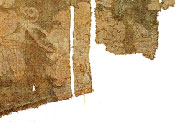 |
 |
||||||||||||||||
 |
|||||||||||||||||
 |
|||||||||||||||||
| Classified Glossary | |||||||||||||||||
 |
|||||||||||||||||
 |
|||||||||||||||||
| 24. 1Velvet Velvet is a warp-pile weave. A pile warp (rongjing) is raised in loops (rongquan) by rods (qironggan) above a ground weave during weaving. Velvet is divided into several categories including: 1. cut velvet (pingrong), all loops cut to form the velvet; 2. partly cut velvet (diaohuarong or Zhangrong), pattern created by areas of cut and uncut pile; 3. uncut velvet (quanrong) with a loop pile; and 4. patterned velvet or cisel?velvet (zhangduan), patterned piles were cut but all the rest remains. Fulled fabrics, where the surface has been brushed to create a pile-like surface, are often mistaken for velvet. 25. 1Ikat Textile patterned by resist dyeing yarns before weaving. This technique includes warp ikat (jingbingjin), weft ikat (weibingjin), double ikat (shuangbingjin) and piled ikat (pulu). The most famed ikat from China is Khotan ikat from Xinjiang, called Ederis in the local language, is a warp ikat. 26. 1Silk tapestry/kesi/ko-ssu Silk tapestry (kesi) woven with the technique where one set of warp ends is woven with discontinuous weft lats of different colours in tabby weave. It can be written either as kesi or k'o-ssu. The technique originated from wool tapestry, which was adapted to silk in China in the Tang dynasty first by the Uyghurs, and became popular in the Song dynasty. |
|||||||||||||||||
| THE BOOK | |||||||||||||||||
| AUTHOR | |||||||||||||||||
| CONTENTS | |||||||||||||||||
| ORDER | |||||||||||||||||
| CONTACT | |||||||||||||||||
| LINKS | |||||||||||||||||